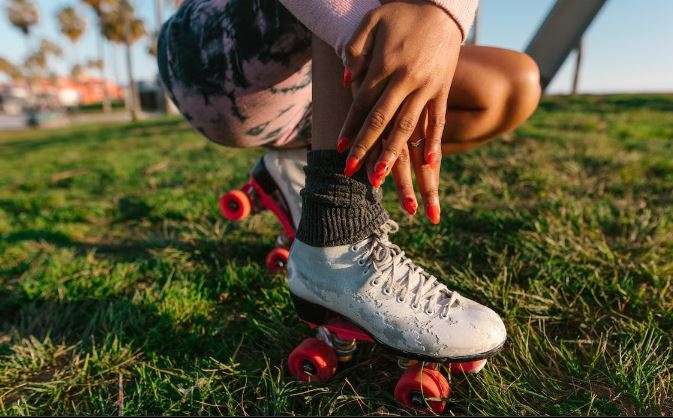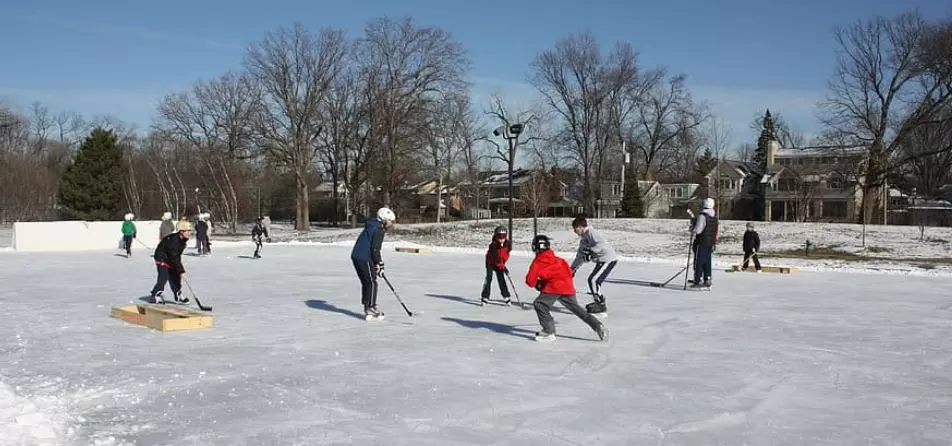Last updated on December 11th, 2022 at 08:09 am
Can Roller Skating Cause Shin Splints? If you are reading this post, it means you want to learn about if roller skating can cause shin splints.
And if you have been roller skating for a long time, you would agree with me that it is fun. Perchance, it essentially triggers dopamine release, helping you feel better when you engage in skating.
Although skating manages stress, and as well have tons of physical and social benefits. Having several benefits, it can be a risky sport. So far, a shin splint is one of the roller-skating dangers and could ruin your fun as you would be in severe pain.
Shin splints mainly occur in athletes, dancers, military recruits, and those involved in high-impact sports or non-sports activity due to intense training patterns, which might have led to overuse of the muscles.
Moreover, if you are a newbie to roller skating, all you could be getting from your indoor and outdoor sports is shin pain rather than fun and as much losing your touch for roller skating.
However, this article is for you as it will help to illuminate the following vital contents for your understanding; can rollerblading give you shin splints? Is roller skating well for shin splints?
Can skate cause shin splints? Why do my legs hurt after roller skating? Does skating hurt shins, and many more?
Without much ado, let’s get to it!
How Do You Stop Your Shins From Hurting When Roller Skating?
Shin splints are common injuries from roller skating from the repetitive stress of the muscles in the front of the tibialis, which lead to pain and inflammation in that place.
To stop your shin from hurting you when you roller skate involves the following steps;
Here you have them!
- Avoid much pressure on your shins as you have good form.
- Stretch your shins and calves before and after skating to avoid tightening the shins after 10 minutes.
- You should take vitamin supplements to prevent leg pain. However, vitamin D enhances the absorption of calcium to facilitate strong bones.
Can Rollerblading Give You Shin Splints?

Yes, rollerblading can give you shin splints due to the following reasons;
· Over Skating
It is likely that anything done excessively could cause disaster, and rollerblading is not an exception. So, when you rollerblade, your feet are involved in pushing and gliding to help propel the motion of your body.
Hence, skating done more than required overstretches your shin, its tendons, muscles, and even the shin bone itself. Though, when this happens, a piercing pain comes to you to the point that you cannot bear it, and rollerblading becomes a hassle for you to practice.
· Faulty Skating Skill?
Poor or faulty skills like straightening the knees rather than staying low as you bend your knees could cause rollerblading to give shin splints. Hence, good posture is necessary to avoid shin splints, so you should take complete care to discharge the skill appropriately.
· Hard And Rough Surface?
In as much as rollerblading can be done on surfaces like asphalt, concrete, plastic, or even off-road. Perchance, the best cover for rollerblading shouldn’t be too hard, rough, or slick. So far, it will be abnormal for your body to move efficiently and, in turn, could cause shin splints.
Is Roller Skating Good For Shin Splints?
No, it is not suitable for shin splints since it triggers this issue; you cannot continue with roller skating. Hence, if you are experiencing a shin splint, it would be advisable to rest for a few days and apply the correct posture, or you could be engaged in warm-ups before and after roller skating.
Can Roller Skating Cause Shin Splints?
Of course, yes, it can!
As much as roller skating is enjoyable and exciting for people who are enthusiastic about feeling the wind in their hair. However, it is paramount to skate carefully with the proper techniques.
To get into it, the causes of shin splints as you practice roller skating could emerge due to the;
- skating too often (over-skating)
- exhibiting poor posture as you skate
- use of unfitting skates or having soft wheels
- lack of adequate skate trucks
- previous medical condition relating to the lower leg muscles.
- Vibrations on your shins and calves due to skate surfaces.
Although, having proper stretches and warm-ups, and supplements to prevent this pain could be helpful.
On the other hand, shin splints are of great concern to sports (roller skating) lovers, so there is no cure for them. Taking perfect rest and reducing your activity level are the possible recommendations to help you heal within a short while if shin splints happen to you.
Can Skating Cause Shin Splints?
Yes, skating can cause shin splints likewise any other sport activity. Although the exact cause is unknown, according to some leading theorists, the shin splint condition is due to the pulling on of the bone covering (periosteum) by the calf muscles as regards much bending across your shin bone (tibia).
Shin splints also occur after sudden changes to most physical activities, which I have stated in this article.
Let’s dive into some of the symptoms of shin splints;
- Muscles pain
- Pain in the front of your lower leg
- Absolute soreness and tenderness along the inner part of your lower leg.
Why Do My Legs Hurt After Roller Skating?
Your legs will hurt you after roller skating when you might have done the following consciously or unconsciously;
- Use of ill-fitting roller skates
- When you overskate
- Having an existing bone disease, and mention just a few.
Does Skating Hurt Shins?
Regardless of the numerous benefits of skating, it is also risky and does hurt your shins when done incorrectly in terms of techniques, improper use of materials (trucks or wheels), and overusing one of your legs (stress).
Notwithstanding, anyone with medical conditions that involve the leg muscles and shins will have a very difficult time skating. Sometimes, the pain could hinder the person from participating in any form of skating.
So far, I recommend that such a person(s) follow his medical adviser’s instructions before skating.
How Do You Stretch Out Your Shins?
Shin splints are aching pains caused by overuse and stress along the front of your lower leg, perhaps where your muscles are attached to your shinbone.
Although, I will explore this stretch in 3 categories;
1. The Kneeling Shin Stretch
Precisely, the goal of this stretch is to be effective on the front of the anterior tibialis muscle to relieve the pain in the shin.
Procedure:
- Kneel, sit to enable your knees to be in front of your body through your heels beneath your glutes.
- Placing your hands on the ground as you lean back would be best.
- It would help if you used your body weight to push down the heels to feel the stretch as you lift the knees to intensify pressure.
- Hold up for about 30 seconds, as you could have desired rep thrice daily.
2. The Calf Raises?
This stretch also relieves shin splints by strengthening the calf muscles. You can do it with a step stool or on a flat surface.
Procedure:
- You should stand on a flat surface and make your feet flat.
- Adjust your weight to the balls of your feet and the mid-foot; gradually lift your heels, hold them for about 10 to 20 seconds, and slowly return them down.
- Repeat this for 3 to 5 minutes.
- If desired, switch legs and repeat the stretch on the other leg.
- You could have your desired rep twice daily.
3. The Seated Shin Stretch
Procedure:
- You should extend one knee in front of the other as you sit on a chair and extend your toe to the floor.
- Slowly adjust the body weight forward using your toe planted on the floor to make the stretch on the shin.
- Hold unto this position for about 15 to 20 seconds, then have a 3 to 5 times repeat.
- If desired, perform the stretch on the other leg as you switch.
- Do desired reps multiple times daily.
Why Do My Legs Hurt When I Skate?
Newbie skaters often experience or feel hurt in the lower leg. However, these pains are due to the following causes below;
· Burning Calves And Feet
The above is the most common because the lower leg and foot should be proper to this activity known as skating.
This pain could also arise if you have not skated for months.
· Faulty Technique
Straightening the knees and bending forward puts much pressure and stress on the shins and the toes as regards the improper application of skills.
· Too-Tight Skates?
Inability to acquire the right way on how snugly to lace and buckle a pair of skates. Hence, snugged-fit skates will enhance performance, though pains and bruising on the leg mean your skates are too tight.
Why Do My Calves Hurt When I Rollerblade?
Your calves hurt when you rollerblade if you have positioned your hips to fall back in line with your heels. That said, it will pressure you to bend at your knees, putting you into a semi-crouching situation.
Similarly, your bent knees help the hips to support your body weight and lift off your lower body, including the calf muscles, for less strain. So far, if you don’t perform or make the right move as above, you might strain your calves during rollerblades.
Conclusion
It is not funny or pleasant when your shin and calves are seized up into massive muscle cramps, but if such happens, the skating technique is wrong; enormously tight/loose trucks or even the wheels of your skate could be too soft.
Nevertheless, I have written a detailed work above, and eventually, in the course of roller skating, the shin splints arise and do have some stretches for the pains to be relieved.
Hence, if the shin splint from skating persists for more than two weeks after you have tried all suggestions and recommendations, it would be best to consult or visit a doctor. In essence, it could have been a condition that needs medical care.
I hope you find the correct answers to your questions. Do like and share this informative article with others!





